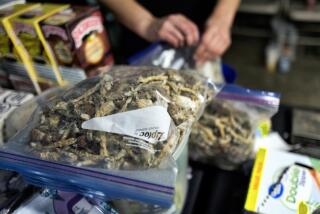A fight to say no to chemo
- Share via
A TRIAL NEXT month in Virginia will determine what kind of medical treatment Abraham Cherrix, a 16-year-old with Hodgkin’s disease, will receive. At the same time, the case will call into question the definition of “alternative” medicine and just how much of a role government should have in our private lives and medical decisions.
Cherrix has already had one debilitating course of chemotherapy. Nevertheless, a juvenile court ruled recently that he must undergo a second course instead of following the organic, herbal treatment he has chosen with his parents’ consent. A circuit court judge this week suspended the ruling and ordered the trial.
According to a recent story on Cherrix in USA Today, chemotherapy rendered the 6-foot-1 teenager so weak that he couldn’t walk from his car to his home. He felt deathly ill after treatment and feared at times that he wouldn’t make it through the night. So Cherrix did research and found an alternative -- the “Hoxsey herbal treatment” -- administered by a clinic in Mexico. It calls for a diet of organic food and herbs, eliminating, among other things, sugar, tomatoes and white flour.
His parents supported his choice despite the American Cancer Society’s opinion that “there is no scientific evidence” that the Hoxsey method treats cancer effectively.
Together, a family believed that they might have found a less harmful answer to their problem and that they had the right to pursue it. It turns out they were wrong -- at least in Virginia, where even your medicine and family structure may be regulated by the county.
Of course, Western methods of treating Hodgkin’s disease offer patients an 85% survival rate after five years. This fact alone calls into question Cherrix’s decision. Still, although chemo and radiation protocols may be more cut-and-dried now, varying formulas and blends remain. And it’s still a crapshoot how a person will respond to any treatment and what the long-term side effects will be.
Unfortunately, the concept that a mature teenager might choose a so-called alternative path for himself with parental support was so offensive to the Accomack County social services agency that Cherrix’s parents were ordered by the juvenile court to share custody of their son with the county and face punishment for medical neglect. The circuit court ruling ended the joint custody.
All I can say is how dare they?
As an 18-year-old, I had the most dangerous form of Hodgkin’s lymphoma, and I wasn’t given treatment options either. My parents and doctors told me I was sick, and I followed instructions: six months of chemo, then radiation.
I was then told that I was cured, even though I now see in my records that my white blood cell count was elevated after the “cure.”
Only two years later, when a lymph node the size of a golf ball appeared on my neck, was I re-diagnosed. I followed orders once more after my parents chose a new doctor, who prescribed more chemo (ineffective) and a stem cell bone marrow transplant.
I’m 29 now and thankful that I’m here to tell the story. But I face many long-term effects from the “sublethal” treatments I endured. I must see neurologists, neuro-oncologists, neurosurgeons, rheumatologists, dermatologists, endocrinologists, gastroenterologists and other specialists. The consensus: 10 years later, I have mysterious health issues that are most likely the results of my so-called cure. And no one knows what to do.
Do I wish I had tried something else in the past? Maybe, but probably not. I was in a near-emergency state. I needed serious help, and quickly.
I do, however, recall feeling trapped with few choices -- not even able to choose one hospital over another. My family and I were aware of alternative treatments that we had found in books. But they weren’t considered options. We felt too scared to abandon Western medicine -- perhaps more scared than necessary because of the sway it holds over America’s cancer culture.
Now I see that these paths might have helped me. I now employ many “alternatives” to help treat my current condition while I wait for Western medicine to say something -- anything.
So what constitutes “alternative treatment”?
The chemo-and-transplant combination that I received was developed by an expert renowned for his medical protocols. But there are others I was never told about. And who’s to say that his method wasn’t “alternative”? When he came up with it, it certainly was. Would the social services agency step in if Cherrix had found a pioneering doctor who had concocted new mixes of pharmaceutical-grade chemicals to fight Hodgkin’s disease?
To be sure, patients with serious or potentially fatal illnesses who circumvent Western medicine run a serious risk of missing out on a cure. But spontaneous remissions occur every day, baffling doctors. And many of the doctors I see regularly, post-Hodgkin’s, have no official explanation for what’s going on in my body after all the chemical and cellular experimentation.
I say that if doctors are allowed to send you home without diagnoses after all their expensive, painful tests -- and troubling test results -- everyone, even a mature, educated teenager, especially with parental consent, should be able, without governmental intervention (or more obscene, punishment), to take his health into his own hands.
More to Read
Sign up for Essential California
The most important California stories and recommendations in your inbox every morning.
You may occasionally receive promotional content from the Los Angeles Times.













